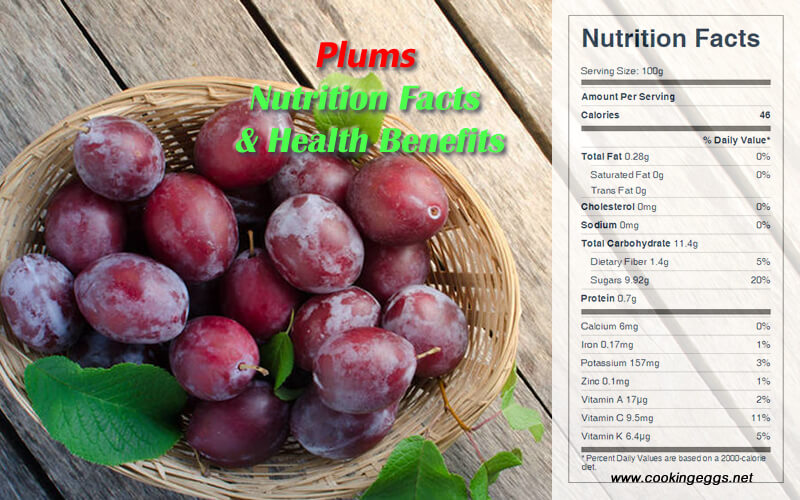Plums Nutrition Facts & Health Benefits
Plums are grown in many parts of the world and there are more than 100 types of plum. They are valued as a rich energetic source with high protective, dietetic, and therapeutic value.
The nutritional value of plums
Raw plums are 87% water, 11% carbohydrates, 1% protein, and less than 1% fat.
One medium raw plum provides 36 calories, 8.6 g carbohydrate, 0.5 g protein, 0.4 g fat, 0.9 g dietary fiber, 213 IU vitamin A, 6 mg vitamin C, 1 mcg folic acid, 114 mg potassium, 3 mg calcium, 7 mg phosphorus, and 5 mg magnesium.

Raw Plums Nutrition Facts Label
Health Benefits of Plums
Plums grow in many parts of the world, including North and South America, Europe, and Asia. Varieties that originated in Europe tend to be purple-skinned, but there are other varieties that are white-, yellow-, green-, or red-skinned. Inside, the flesh of plums can be white, green, orange, purple, pink, black, or red.
The more purple the plum, the more anthocyanins it is likely to contain. Anthocyanins are flavonoids with free radical scavenging ability against reactive oxygen species. The major types of anthocyanins in plums are cyanidin and peonidin.
Plums can be eaten fresh or dried; when dried, they are called prunes. Plums, fresh and dried, are thought to be a rich natural source of sugars, acids, vitamins, minerals and phytochemicals such as avonoids, phenols and other phythochemicals for which it has been determined that they have antioxidant activity and may help protect cells against the oxidative damage caused by free radicals.
They are a good source of calcium, magnesium, potassium, vitamins B and C, lutein, and beta-carotene. Plums are also a significant source of the trace mineral boron, which is helpful in converting calcium to bone and may therefore play a role in preventing osteoporosis.
Plums, along with prunes, have earned their reputation as a remedy for constipation. In addition to a healthy dose of fiber, they contain sugars, including sorbitol, a sugar alcohol that draws water from the intestine to produce a laxative effect, and isatin.
Although plums are quite sweet, they don’t cause blood sugar to spike, probably because of the fiber, fructose, and sorbitol that all contribute to slowing down absorption of the sugars.
Plums have antibacterial, antiviral, diuretic, and laxative properties. They provide energy, stimulate the liver, and are considered a tonic for the brain, nerves, and blood.
Plums and prunes have a reputation as remedies for digestive problems, but they are also great contributors to our overall gut health and to maintaining a strong metabolism and immune system.
The phenolic compound, chlorogenic acid, also has a huge effect on the gut. Chlorogenic acid gets metabolized in the colon by the microbiota and forms the by-product caffeic acid, which has been shown to stimulate Bifidobacterium.
Bifidobacterium species play a critical role in regulating our immune system. This genus of probiotics increases T regulatory cells, which we know helps to balance our immune system.
Plums have numerous health benefits, including benefits for our bones and memory, as well as antioxidant and antiinflammatory properties.
Health Risk
Plums contain some oxalic acid, which can inhibit the body's absorption of iron and calcium. People with ulcers or acute gastroenteritis should limit their intake of plums and prunes.
Selection & Storage
Fresh plums are available all summer, from May through October. Plums do not ripen much after picking, so buy them ripe and eat them within a day or two. They will keep at room temperature for only a day or two, slightly longer if refrigerated.
A good, ripe plum has a rich color and a smooth, full-feeling, intact skin with no holes, bruises, soft spots, or leakage.
Plums may have a whitish, slightly waxy substance on the skin. This is called "bloom" and is a sign that the fruit has not been over-handled.
The darkest purple plums, like Black Friars, have the most anthocyanins, but other colors may have more carotenes. Choose a variety of plums throughout the season for the most benefit.